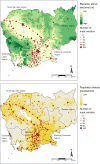Access to food markets, household wealth and child nutrition in rural Cambodia: Findings from nationally representative data
- PMID: 37851642
- PMCID: PMC10584123
- DOI: 10.1371/journal.pone.0292618
Access to food markets, household wealth and child nutrition in rural Cambodia: Findings from nationally representative data
Abstract
Access to informal fresh food markets plays a vital role in household food security and dietary quality in transitioning rural economies. However, it is not well understood if market access also improves child nutrition and if the improvement applies to all socioeconomic groups. In this secondary research study, we combined a national listing of food markets (n = 503) with a national household survey to examine the associations of market access with diet and height across wealth groups in children aged 6 to 23 months in rural Cambodia. All children under two years of age with dietary data (n = 1537) or anthropometry data (n = 989) were selected from the household survey. Food markets were geocoded using Google Maps or villages' geographical coordinates publicly available in the Open Development Mekong data platform. Regression calibration was then used to estimate household distance to the nearest market. Descriptive results indicated a highly uneven distribution of food markets with median household distance to the nearest markets ranging between 4 km (IQR: 3-8 km) in the lowland areas and 9 km (IQR: 4-17 km) in the highland areas. Results from the multivariate linear regressions showed that distance to the nearest market was modestly associated with child dietary diversity score (β: -0.17; 95% CI: -0.29, -0.05) but it was not related to child height-for-age z-score, and that household wealth did not modify the associations between distance to markets and child dietary diversity score. These findings suggest that improving access to food markets alone might not lead to meaningful improvement in child diet. Detailed surveys on household food acquisition are needed to clarify the role of food markets relative to other food sources such as subsistence fisheries, subsistence gardening and mobile food traders.
Copyright: © 2023 Duong et al. This is an open access article distributed under the terms of the Creative Commons Attribution License, which permits unrestricted use, distribution, and reproduction in any medium, provided the original author and source are credited.
Conflict of interest statement
The authors have declared that no competing interests exist.
Figures



References
-
- Bhutta ZA, Das JK, Rizvi A, Gaffey MF, Walker N, Horton S, et al.. Evidence-based interventions for improvement of maternal and child nutrition: what can be done and at what cost? The Lancet. 2013;382(9890):452–77. - PubMed
-
- Victora CG, Christian P, Vidaletti LP, Gatica-Domínguez G, Menon P, Black RE. Revisiting maternal and child undernutrition in low-income and middle-income countries: variable progress towards an unfinished agenda. The Lancet. 2021;397(10282):1388–99. doi: 10.1016/S0140-6736(21)00394-9 - DOI - PMC - PubMed
-
- United Nations Children’s Fund (UNICEF). Fed to Fail? The Crisis of Children’s Diets in Early Life. New York: UNICEF; 2021.
Publication types
MeSH terms
LinkOut - more resources
Full Text Sources

